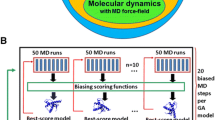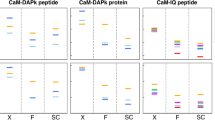Abstract
Most proteins comprise several domains and/or participate in functional complexes. Owing to ongoing structural genomic projects, it is likely that it will soon be possible to predict, with reasonable accuracy, the conserved regions of most structural domains. Under these circumstances, it will be important to have methods, based on simple-to-acquire experimental data, that allow to build and refine structures of multi-domain proteins or of protein complexes from homology models of the individual domains/proteins. It has been recently shown that small angle X-ray scattering (SAXS) and NMR residual dipolar coupling (RDC) data can be combined to determine the architecture of such objects when the X-ray structures of the domains are known and can be considered as rigid objects. We developed a simple genetic algorithm to achieve the same goal, but by using homology models of the domains considered as deformable objects. We applied it to two model systems, an S1KH bi-domain of the NusA protein and the γS-crystallin protein. Despite its simplicity our algorithm is able to generate good solutions when driven by SAXS and RDC data.





Similar content being viewed by others
References
Bax A (2003) Weak alignment offers new NMR opportunities to study protein structure and dynamics. Protein Sci 12:1–16
Brünger AT (1992) X-PLOR: a system for X-ray crystallography and NMR. The Howard Hughes Medical Institute and Department of Molecular Biophysic and Biochemistry, Yale University
Eiben AE, Smith JE (2003) Introduction to evolutionary computing. Springer, Heidelberg
Ginalski K (2006) Comparative modeling for protein structure prediction. Curr opin struct biol 16:172–177
Gabel F, Simon B, Sattler M (2006) A target function for quaternary structural refinement from small angle scattering and NMR orientational restraints. Eur Biophys J 35:313–327
Grishaev A, Bax A (2004) An empirical backbone-backbone hydrogen-bonding potential in proteins and its applications to NMR structure refinement and validation. J Am Chem Soc 126:7281–7292
Grishaev A, Wu J, Trewhella J, Bax A (2005) Refinement of multidomain protein structures by combination of solution small-angle X-ray scattering and NMR data. J Am Chem Soc 127:16621–16628
Kontaxis G, Delaglio F, Bax A (2005) Molecular fragment replacement approach to protein structure determination by chemical shift and dipolar homology database mining. Meth enzymol 394:42–78
Lipsitz RS, Tjandra N (2004) Residual dipolar couplings in NMR structure analysis. Annu rev biophys biomol struct 33:387–413
Losonczi JA, Andrec M, Fischer MW, Prestegard JH (1999) Order matrix analysis of residual dipolar couplings using singular value decomposition. J Magn Reson 138:334–342
Mattinen ML, Paakkonen K, Ikonen T, Craven J, Drakenberg T, Serimaa R, Waltho J, Annila A (2002) Quaternary structure built from subunits combining NMR and small-angle x-ray scattering data. Biophys J 83:1177–1183
Press WH, Teukolsky SA, Vatterling WT, Flannery BP (1992) Numerical recipes in C. 2nd edn. Cambridge University Press, Cambridge
Prestegard JH, Bougault CM, Kishore AI (2004) Residual dipolar couplings in structure determination of biomolecules. Chem Rev 104:3519–3540
Sali A, Blundell TL (1993) Comparative protein modelling by satisfaction of spatial restraints. J Mol Biol 234:779–815
Svergun DI, Barberato C, Koch MHJ (1995) Crysol – a program to evaluate X-ray solution scattering of biological macromolecules from atomic coordinates. J Appl Cryst 28:768–773
Tjandra N, Bax A (1997) Direct measurement of distances and angles in biomolecules by NMR in a dilute liquid crystalline medium. Science 278:1111–1114
Todd AE, Marsden RL, Thornton JM, Orengo CA (2005) Progress of structural genomics initiatives: an analysis of solved target structures. J Mol Biol 348:1235–1260
Wishart DS, Case DA (2001) Use of chemical shifts in macromolecular structure determination. Meth Enzymol 338:3–34
Aknowledgment
We are grateful to Aldjia Mazari (Centre de Mathématiques Appliquées de l’Ecole Polytechnique) for helpful discussions. Fabien Mareuil was supported by a grant of the Institut de Chimie des Substances Naturelles (ICSN). Javier Perez benefited from the SAXIER program (Sixth Framework Program). The program suite is available upon request to the authors.
Author information
Authors and Affiliations
Corresponding author
Rights and permissions
About this article
Cite this article
Mareuil, F., Sizun, C., Perez, J. et al. A simple genetic algorithm for the optimization of multidomain protein homology models driven by NMR residual dipolar coupling and small angle X-ray scattering data. Eur Biophys J 37, 95–104 (2007). https://doi.org/10.1007/s00249-007-0170-2
Received:
Revised:
Accepted:
Published:
Issue Date:
DOI: https://doi.org/10.1007/s00249-007-0170-2




